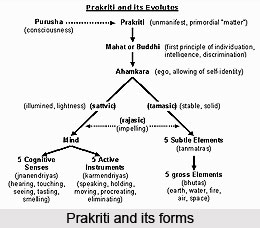 Patanjali Yoga Sutras is the ancient treasure narrating how to keep the body healthy. This yoga sutra is now one of the most acclaimed elements of everyday life. Yoga is an art, a science and a philosophy that touches the life of man at every level, bodily, intellectually and spiritually.
Patanjali Yoga Sutras is the ancient treasure narrating how to keep the body healthy. This yoga sutra is now one of the most acclaimed elements of everyday life. Yoga is an art, a science and a philosophy that touches the life of man at every level, bodily, intellectually and spiritually.All yoga as practiced today is based on Patanjali Yoga Sutras, a collection of aphorisms offered more than 2000 years ago by the Indian sage, Patanjali. Patanjali Yoga Sutras by Maharshi Patanjali is the foundational text for Yoga. Historically, it is believed that Maharshi Patanjali may have lived in around 500 BC to 2000 BC and has compiled mainly three subjects of Patanjali Yoga Sutras namely, grammar, medicine and yoga. Patanjali's three works together deal with man's development as a whole in thought, speech and action.
 Divisions of Patanjali Yoga Sutras
Divisions of Patanjali Yoga SutrasPatanjali Yoga Sutra consists of 196 sutras which are divided into four chapters or padas. Each sutra consists of Sanskrit words that are written in one or two lines. The 196 sutras are precise, reflective and pious in approach. Each of the sutras contains a wealth of ideas and wisdom towards full knowledge of his real nature. The Patanjali Yoga Sutra state, through proper practice one can radiate grace, disposition and compassion. The four chapters or padas of the yoga sutras correspond to the four stages of life. The ultimate achievement of following the path of Patanjali Yoga Sutra is to experience the effortless, indivisible state of the prophet. The four chapters of Patanjanli Yoga Sutras include, Samadhi Pada, Sadhana Pada, Vibhuti Pada and Kaivalya Pada.
Samadhi Pada in Patanjali Yoga Sutras
Samadhi Pada is the first chapter of Patanjanli Yoga Sutra that defines yoga and the movement of the mind and how to reach samadhi state. It is directed towards the individuals who were already highly evolved to enable them to uphold their advanced state of cultured, mature aptitude and wisdom. It is assumed that Patanjali's aim, in beginning was to attract those rare souls who were already on the brisk of self-realisation. In Samadhi Pada, Patanjali defines the yoga as "Citta Vritti Nirodha", meaning to stop the movement of Citta or mind.
Sadhana Pada in Patanjali Yoga Sutras
Sadhana Pada is the second chapter of Patanjali Yoga Sutra, where Patanjali comes down to the level of those who are not spiritually evolved. Patanjali in this chapter identifies that Avidya or spiritual ignorance as the source of all sorrow and unhappiness. Here he coins the word, Kriya Yoga. Kriya means action and KriyaYoga emphasizes the energetic effort to be made by the aspirant. First, he explains the concept of Kriya Yoga, which is the yoga of action and has three tiers, namely tapas, svadhyaya and Isvarapranidhana. In the chapter of Sadhana pada, Patanjali explains the journey from yama to pratyahara, which is the connection between external and internal.
Vibhuti Pada in Patanjali Yoga Sutras
Vibhuti Pada is the next chapter of Patanjali Yoga Sutra. Vibhuti is the Sanskrit word for "power" or "manifestation". This chapter speaks of the divine effects of yoga sadhana. When a sadhaka attains expertise in the steps of the first 5 steps, he acquires the 8 supernatural powers or siddhis. However, Patanjali cautions that the temptation of these powers should be avoided and the attention should be fixed only on liberation. He then explains that Dharana or concentration, Dhyana or meditation, which comes from repeated concentration and Samadhi, which comes from deep absorption.
Vibhuti Pada is the next chapter of Patanjali Yoga Sutra. Vibhuti is the Sanskrit word for "power" or "manifestation". This chapter speaks of the divine effects of yoga sadhana. When a sadhaka attains expertise in the steps of the first 5 steps, he acquires the 8 supernatural powers or siddhis. However, Patanjali cautions that the temptation of these powers should be avoided and the attention should be fixed only on liberation. He then explains that Dharana or concentration, Dhyana or meditation, which comes from repeated concentration and Samadhi, which comes from deep absorption.
For more, visit the link below: